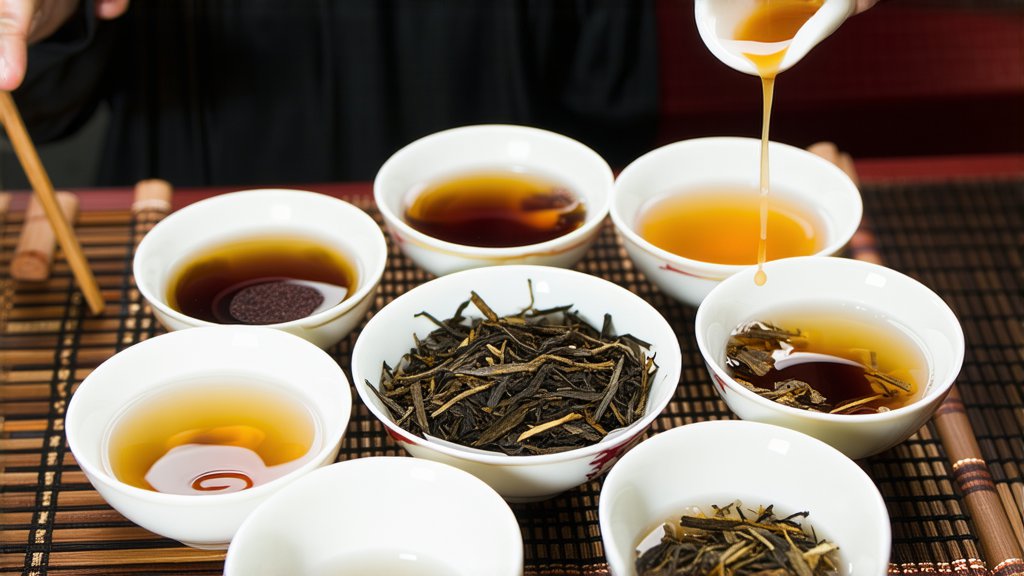
Pu-erh tea, a gem nestled within the vast landscape of Chinese tea culture, stands as a testament to time, tradition, and the art of transformation. Originating from the Yunnan province, this dark tea variety has not only carved a niche for itself in China but has also garnered international acclaim for its distinctive flavor profile, medicinal properties, and the fascinating science behind its maturation process. This exploration delves into the historical roots, diverse classifications, meticulous production methods, and the nuanced art of appreciating Pu-erh tea.
Historical Roots & Evolution
The story of Pu-erh tea traces back over a millennium, intertwining with the ancient trade routes that connected China to Tibet and beyond. Its name is derived from the market town of Pu'er in Yunnan, where these teas were traditionally processed and traded. Historically, Pu-erh was a crucial component of the Tea Horse Road, serving as a barter item for horses, which were highly valued for their military and transportation capabilities. This long-distance trading fostered the development of unique processing techniques aimed at preserving the tea during lengthy journeys, inadvertently giving birth to the fermentation process that defines modern Pu-erh.
Varieties: Sheng vs. Shou
Pu-erh tea is broadly categorized into two main types: Sheng (raw) and Shou (ripe or cooked). Each embodies distinct characteristics and caters to different palates and preferences.
-
Sheng Pu-erh: Also known as "raw" Pu-erh, it undergoes minimal processing post-harvest, consisting primarily of sun-drying the plucked leaves. This type ages naturally over years, undergoing microbial fermentation that gradually transforms its astringency into a mellow complexity. Sheng Pu-erh is prized for its potential to evolve in flavor over decades, offering a living history in every sip.
-
Shou Pu-erh: In contrast, Shou Pu-erh undergoes a accelerated fermentation process known as "wet piling," where piles of tea leaves are kept moist and warm to encourage rapid microbial activity. This method mimics years of natural aging within months, resulting in a tea with a smoother, earthier taste and a deep reddish hue. Shou Pu-erh appeals to those seeking immediate gratification without the wait associated with Sheng's aging process.
Crafting the Elixir: The Making of Pu-erh
The journey from leaf to cup involves several meticulous steps:
- Leaf Plucking: Only the top two or three leaves and a bud are carefully handpicked during specific seasons to ensure optimal quality.
- Withering: Fresh leaves are spread out to wilt under sunlight, reducing moisture content and softening the cell walls for rolling.
- Rolling: Leaves are rolled into tight spirals, enhancing the extraction of aroma and flavors during brewing.
- Drying: For Sheng Pu-erh, the rolled leaves are sun-dried; for Shou, they proceed directly to the piling stage.
- Piling (for Shou): The hallmark of Shou production, this involves layering the rolled leaves in large piles, maintaining high humidity and temperature to facilitate microbial fermentation. Regular turning ensures even fermentation.
- Aging & Storage: Both Sheng and Shou Pu-erh benefit from proper storage conditions—cool, dry environments away from strong odors—to further refine their flavors over time.
The Art of Tasting Pu-erh
Appreciating Pu-erh tea transcends mere consumption; it is an experience steeped in ritual and mindfulness. Here’s how to embark on this sensory journey:
- Preparation: Use a Yixing clay teapot or a Gaiwan for the authentic experience. Rinse the leaves briefly with boiling water to awaken their flavors.
- Infusion: Steep the leaves in near-boiling water (around 95°C), adjusting the steeping time according to personal preference and the age/type of Pu-erh. Generally, start with shorter intervals (5-10 seconds) and extend as subsequent infusions release more character.
- Observation: Note the color transformation of the liquor—from bright amber in younger Sheng to deep burgundy in aged Shou.
- Aroma: Inhale the evolving scents, ranging from fresh earthiness in Sheng to rich, woody notes in Shou.
- Tasting: Savor the complexity on your palate—the initial bitterness that gives way to sweetness, umami, and a lingering aftertaste that tells tales of its origins and maturity.
- Multiple Infusions: Pu-erh is renowned for its resilience, allowing multiple infusions (up to 10 or more) each revealing new dimensions of flavor.
Health Benefits & Cultural Significance
Beyond its captivating taste, Pu-erh tea has been revered for centuries for its purported health benefits. Rich in antioxidants, polyphenols, and probiotics due to its fermentation process, it is believed to aid digestion, promote weight loss, regulate blood sugar levels, and support cardiovascular health. Moreover, it holds a symbolic place in Chinese culture, often associated with longevity, prosperity, and a bridge between generations through shared tea ceremonies.
In conclusion, Pu-erh tea is not just a beverage; it is a cultural artifact, a testament to nature's wonders, and a reflection of human ingenuity. Whether you are drawn to the raw vitality of Sheng or the matured depth of Shou, exploring Pu-erh is embarking on a voyage through time and taste, where every cup narrates a story waiting to be discovered.